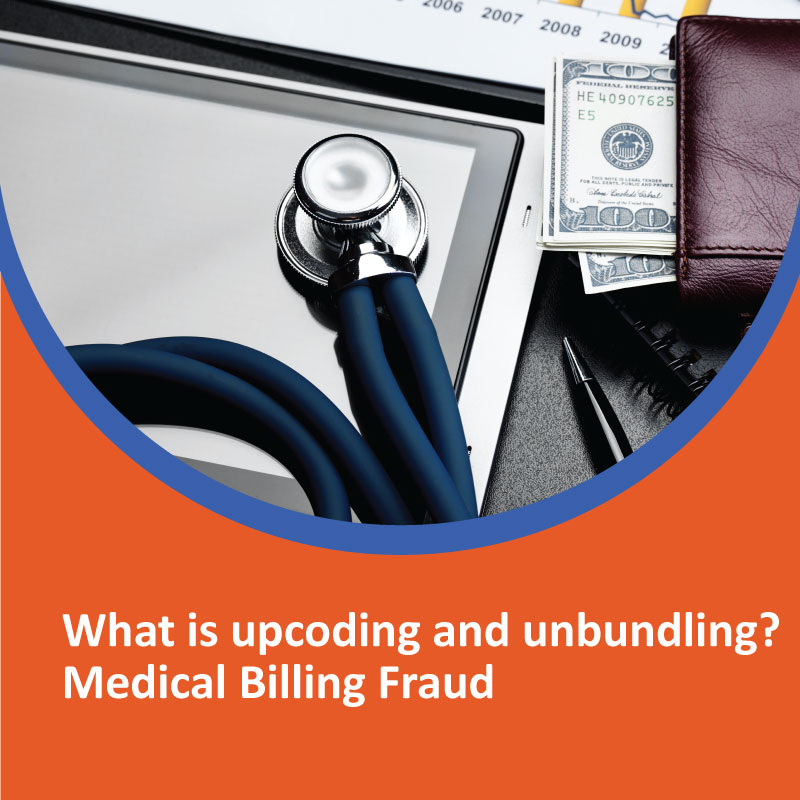Fraud in medical billing involves a broader range of illegal practices and may occur in different settings. At basic levels, medical billing fraud involves a healthcare practitioner who bills for services they did not provide. Furthermore, billing fraud is also one of the most common forms of Medicare fraud. However, improper billing practices can take different forms – thus making it more challenging to identify. Two of the most prevalent ways of fraud are upcoding and unbundling. While many other fraudulent schemes exist – when a healthcare provider submits fraudulent bills for payment, they may fall liable under the False Claims Act.
To that effect, let’s explore what is upcoding and unbundling in healthcare.
What is unbundling?
Unbundling medical billing is a type of fraud similar to upcoding. For unbundling, the healthcare providers bill multi-step and complex procedures separately – instead of doing it as a single coded procedure. Billing the individual steps lets healthcare providers fetch more reimbursements for rendering the same services. Unbundling, a.k.a fragmentation, is where a provider fragments a single procedure into multiple codes to achieve higher reimbursements.
Occurrences of Unbundling in Medical Billing
Instances of unbundling mainly occur in medical coding. For example, for a routine surgical procedure, a healthcare practitioner engaging in unbundling might put separate codes for incision and suturing instead of using a standard billing code. What this does is significantly increase a provider’s reimbursement.
Next, on upcoding and unbundling, we have the upcoding in healthcare.
What is Upcoding?
The upcoding definition refers to using inaccurate billing codes to obtain higher reimbursements for a medical procedure or treatment. In easier words, upcoding is when a provider is charging at a higher level for services. Through upcoding the treatment as more severe or complex – healthcare providers fraudulently obtain higher reimbursement.
For instance, a physician may code a patient with acute bronchitis as being treated for chronic bronchitis. Or providers can code the excision of a small skin cut as an excision of a complicated and larger excision. Both of these instances of upcoding result in cost differences and increased profit for the provider. Healthcare practices guilty of upcoding or unbundling can expect serious penalties and fines.
Differences between Upcoding and Unbundling in Healthcare
In healthcare billing, understanding the differences between upcoding and unbundling is vital to ensure fair and accurate financial practices. Here’s a breakdown of the two concepts:
| Characteristics | Upcoding | Unbundling |
| Definition | Upcoding involves assigning billing codes that represent a service or condition as more severe, complex, or costly than what was actually provided or diagnosed. | Unbundling is when multiple procedure codes are billed for the services which should have been billed under a single, comprehensive code. |
| Effects and Result | The result of upcoding is increased reimbursements for a specific service or condition by making it appear more serious or complex than it truly is. | This is another fraudulent practice which results in higher reimbursements by breaking down a bundled procedure into its individual components and billing each one separately. |
| Occurrence | Upcoding can happen either intentionally, as a result of a deliberate attempt to boost reimbursements, or unintentionally which can happen due to clerical errors or misunderstandings of coding guidelines. | Unbundling is often a deliberate strategy to maximize reimbursement, although at times it may occur due to misunderstandings about how to bill for certain services. |
| Detection Methods | Upcoding can increase patient bills, particularly when insurance coverage falls short. Furthermore, it distorts the patient’s medical record, potentially influencing future healthcare decisions. | Audits, whistleblower complaints, or data analysis that reveals irregular billing practices are methods used to detect upcoding. |
| Impact on Patients | Upcoding can lead to higher patient bills, particularly when insurance coverage falls short. Furthermore, it distorts the patient’s medical record, potentially influencing future healthcare decisions. | Unbundling may lead to patients being overcharged for services, especially if they are to bear some of the costs. |
| Legal Implications | Considered a form of fraud, upcoding carries significant legal consequences, encompassing both civil and criminal penalties. | Payers typically notice unbundling when services typically bundled into a single charge are billed separately. This is identified through careful examination of billing practices. |
Understanding these differences between upcoding and unbundling is essential for healthcare providers to maintain ethical billing practices, avoid legal repercussions, and ensure fair financial dealings within the healthcare system.
Upcoding in Healthcare
In healthcare, accurate documentation of patient care is essential. When it comes to medical billing, doctors ensure that they bill for the services they provide using standardized billing codes that correspond to specific procedures or treatments.
Upcoding is a practice where doctors, whether in primary care or various specialties like psychiatry, ophthalmology, dermatology, orthopedics, pain management, wound care, and others, use billing codes that suggest more costly services than what was actually delivered. This can take the form of assigning a code for a complex procedure when, in reality, a routine one was performed.
Another form of upcoding involves billing for a patient visit that lasted longer than it did in reality. Many doctor services billing uses Evaluation and Management codes (E&M), reflecting the complexity and purpose of the patient visit. Upcoding, in this case, occurs when an E&M code indicating a more complex and time-consuming visit is used, despite the actual service being less extensive.
Furthermore, modifier codes, which signify additional services during a patient visit, are another tool doctors may employ for legitimate purposes. However, upcoding occurs when a modifier code suggests additional services are given to the patient, even when the standard code already covers those services for the patient visit.
Implications of Upcoding
Upcoding in medical billing raises ethical concerns, as it involves misrepresenting the complexity and extent of services provided. Such practices can contribute to medical billing fraud, compromising the integrity of the healthcare system and potentially leading to financial repercussions for practitioners and patients. It is important for healthcare providers to stick to transparent and accurate billing practices, building trust and maintaining ethical standards in the medical profession.
Hospitals and Upcoding: A Closer Look at Medical Billing Practices
Upcoding is a medical billing fraud that extends its reach to larger scales, including hospitals and healthcare facilities. The expenses of inpatient care from the hospitals are in regulation through the pre-determined rates. These rates depend on the diagnosis-related group (DRG) assigned to a patient, directly linked to the severity of their diagnosis and the type of stay required. These factors are determined based on diagnosis codes, commonly known as the ICD codes.
Hospitals often engage in upcoding practices, and two prevalent types are as follows:
- Misrepresentation of Provider Services – One common upcoding practice involves hospitals billing for physician care services when, in reality, the services were rendered by a lower-paid healthcare professional, like a nurse or physician’s assistant.
- Inflated Severity Levels for Routine Care – Hospitals may also engage in upcoding by billing an inpatient stay at the highest severity level of care, even when the patient received standard care without any additional diagnoses, major complications, or comorbidities.
Understanding the aspects of upcoding and unbundling is essential for fighting medical billing fraud within the healthcare system. By being aware of such practices, stakeholders can work towards ensuring transparency and fairness in healthcare billing processes.
Medical Billing Fraud – Exploring Upcoding with Other Healthcare Providers
Various healthcare providers may also indulge in improper upcoding and unbundling practices. Take, for instance, a home healthcare agency that inaccurately reports providing more time-intensive services to a patient than they actually delivered—an example of upcoding. Similarly, an urgent care facility might engage in upcoding by billing for medical services that appear more extended or complex than those provided. Durable medical equipment providers (DME) can also partake in upcoding if they submit bills for more expensive equipment than what was supplied.
Why is Upcoding Illegal?
Upcoding is illegal because hospitals mislead Medicare about the nature of medical services and treatments. The healthcare facilities falsely claim to provide more expensive services than they do. Such deceptive practices lead to Medicare over-reimbursing the hospitals for these fictitious treatments, potentially diverting billions of taxpayer dollars to these fraudulent healthcare providers. Recognizing the impact of upcoding is crucial in safeguarding the integrity of healthcare billing systems and preventing financial fraud at taxpayers’ expense.
Other Forms of Medical Billing Fraud
Studying billing fraud highlights that upcoding and unbundling fraud rarely exists in isolation. Instead, upcoding and unbundling frequently coexist with other illegal, unethical, or fraudulent billing practices. Various types of medical billing frauds, in addition to upcoding and unbundling, include:
Double Billing
Double billing is a deliberate act where a provider intentionally invoices both Medicare/Medicaid and a private insurance company or the patient for the same treatment. If two providers attempt to bill for services given to the same patient for identical procedures on the same date, it is termed double billing. Additionally, double billing can occur when providers bill for the same procedure initially using an individual code and subsequently as a bundled code.
Bill Padding
Bill padding takes place when healthcare providers inflate a bill by adding unnecessary costs, such as consults and administered medicine. For instance, providers may attempt to pad the bill if they unnecessarily request physician consults or procedures.
Billing for Services Never Rendered
Bills can also include entries for services like texts, medicine, or visits that were never actually provided. This deceptive practice contributes to financial indecency within the healthcare system.
Conclusion
The fraudulent activities, whether in individual practices or large healthcare institutions, lead to increased reimbursements through misrepresented services. Furthermore, it is important for medical providers to understand the differences between upcoding and unbundling, recognizing their ethical implications and legal consequences. Staying vigilant against such billing frauds is essential for preserving the integrity of healthcare systems, ensuring fair financial dealings, and safeguarding the trust in the medical profession.



